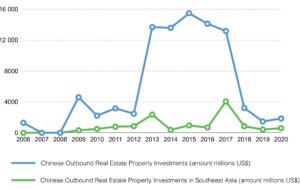In this paper published in Asia Pacific Viewpoint, Adèle Esposito Andujar, Gabriel Fauveaud, Marie Gibert-Flutre, Natacha Aveline-Dubach, Carine Henriot, et al. examine how Chinese transnational investments, as (re)framed in the Belt and Road Initiative (BRI), contribute to changes in urbanization processes in Southeast Asia.

Large (at least $100 million) Chinese outbound real estate property investments from 2006 to 2020. Data retrieved from the China Global Investment Tracker produced by the American Enterprise Institute. [Colour figure can be viewed at wileyonlinelibrary.com]
While urban population rates remain lower in Southeast Asia than in Europe or China, Southeast Asian cities have over the last three decades experienced intensified urban dynamics, bolstered by China’s growing role in urban and industrial politics in secondary cities, small national capitals, rural sites in transition, and emerging urban sites in search of development levers. Large projects such as SEZs, industrial and infrastructure projects, and urban mega-projects initiated by local and national elites can be incorporated into the BRI through the involvement of Chinese private and public capital and expertise.
This work was supported by the French Research National Agency (Agence Nationale de la Recherche) in the framework of the research program ‘The Cities of the New Silk Roads in Southeast Asia’.
Adèle Esposito Andujar, Gabriel Fauveaud, Marie Gibert-Flutre, Natacha Aveline-Dubach, Carine Henriot, et al.. How does the ‘Belt and Road Initiative’ change urbanisation patterns in Southeast Asia?. Asia Pacific Viewpoint, inPress, ⟨10.1111/apv.12391⟩. ⟨halshs-04244225⟩


